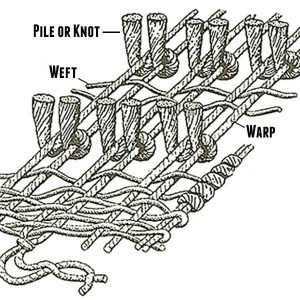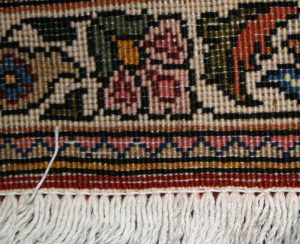|
|
|
|
|
|
|
|
In-Plant Rug Cleaning is recommended for Oriental Rugs and loose woven rugs. They should not be cleaned on location like wall to wall carpet. Our company cares for the finest to the most basic rugs from around the world. We will pick your rug up and bring it to our special cleaning plant where it will receive our very thorough Nine Step Cleaning System to get maximum roil and spot removal. Having your rug cleaned in our plant allows us to give it several treatments for a more thorough cleaning, controlled drying, and the use of various tools that are not available on location.
Buddy’s Carpet Care uses the Ausersehlian Cleaning System on your fine textile rugs. This world-renowned system has been proven to be one of the best, most efficient and safest ways to wash Orientals. We use authentic hand washing and compressed air cleaning for our fine textiles. Your valuable rugs are thoroughly yet gently cleaned.
Step 1: Pre-Inspection and Pick Up
We will determine as much as we possibly can about the type of rug and inherent qualities that may affect cleaning. We will outline the expected results and cleaning “prescription”. Our inherent qualities that may affect cleaning. One of our trained technicans will come to your home to pick up your rug, or you may drop it by our shop.
Step 2: Dry Soil Removal
Woven rugs, especially hand knotted rugs are designed to hide dry soil. A few years ago, the Eureka company did a study and found that a 9×12 could hide 87 pounds of dirt! Wow! We use a variety of techniques to “dust” the rugs from the front and back. A machine called a pile lifter, special vacuum attachments and any many other methods are implemented. This is the most important step in cleaning any textile.
3. Pre-Condition
Depending on fiber content and soiling type, the rug will be pre-treated to emulsify the soils.
4. Pre-Spot and Fringe Preparation
Any potentially difficult spots will be pre-treated with special solutions to increase chances of removal. The fringe is also pre-treated for maximum soil removal.
5. Shampoo
Depending on fiber content and soiling type, the rug will be pre-treated to emulsify the soils. Most rugs are cleaned with a shampoo that is especially designed to get maximum cleaning while protecting sensitive natural fibers.
6. Rinse or Wash
Depending on the type of rug it will be rinsed with extraction equipment on both sides or washed in a wash pit.
7. Dry
Once the soil is rinsed away, the rug is dried flat or hung to dry in a controlled environment. Proper drying is essential to avoid unnatural shrinkage.
8. Finishing
When the rug is dry, it is combed and finished with soft groomers made for specialty rugs.
9. Post Inspection and Delivery
Our cleaning specialist will give the rug a final inspection and release it for delivery. Your rug will be wrapped in brown craft paper to protect it from dust and environmental soils until it is delivered. Upon delivery, we will lay the rug for you.
In today’s market there are many types of handmade rugs including kilms, sumaks, tapestries, etc. However the rugs most often chosen for a luxurious look and long term use are handwoven knotted pile carpets produced in Iran, India, Pakistan, China, Afghanistan, Turkey, Russia, Rumania, Armenia, and Nepal. A pile rug, which may take months or even years to complete, differs from other hand-made floor coverings in that the knots are individually inserted into the foundation and then cut one at a time.
The quality of an oriental rug not only depends on knot count and materials used, but on many other factors such as complexity of design, number of colors, and dying techniques.
The first things to ask yourself are:
Do the colors and size meet your needs?
Does the carpet look beautiful and fit within your budget?
After locating a few pleasing rugs:
The knot count may vary from 50 to 1,000 knots per square inch. A higher count usually indicates a more valuable rug, but not always. The degree of fineness of the rug can be determined by looking at the back.

The pile should be checked closely for holes, stains, and moth damage (especially in older rugs).
The fringe should be inspected to determine if it is in good shape, is original or the sides of the rug should be strong and fairly straight.
2. The colors should be examined for running. By wiping a damp cloth firmly over the rug, you can determine if the colors will run. Sometimes in new carpets, you will see faded or antique looking effects. These are simply fashionable dying effects to create an antique look.

4. The lay of the rug is important. Often minor imperfections and wrinkles can be easily fixed by stretching or blocking.
It’s standard with most dealers to let you try out different carpets on a “free trial” basis. This will give you the opportunity to find out if your selection fits with your decor.
Finally, there are so many factors that determine the quality and value of an oriental rug that it takes caution and thorough study to make an intelligent purchase. Give Buddy a call if you have any questions! Once you’ve purchased your oriental you will want to make sure it is properly cleaned and cared for regularly. Buddys Carpet Care cleans everything from the finest to the most basic rugs from around the world. We will pick your rug up and bring it to our special cleaning plant where it will receive a very thorough Nine Step Cleaning System to get maximum soil and spot removal.
To learn more about our nine stop oriental rug cleaning process click here!